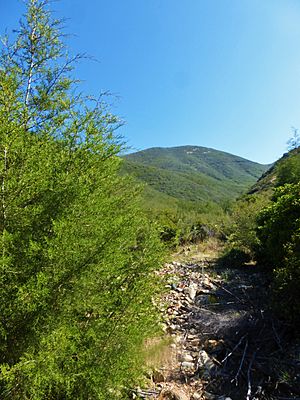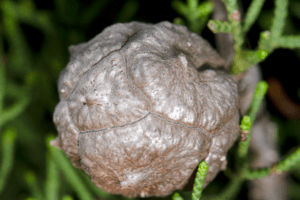Cupressus forbesii facts for kids
Quick facts for kids Cupressus forbesii |
|
|---|---|
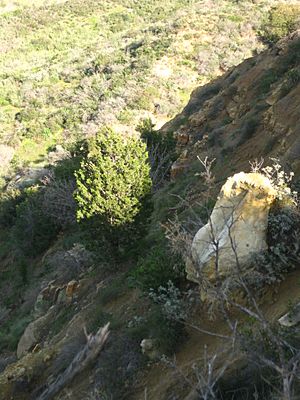 |
|
| One of the few survivors of 2006 Coal Canyon Fire, Cleveland National Forest | |
| Conservation status | |
| Scientific classification | |
| Genus: |
Cupressus
|
| Species: |
forbesii
|
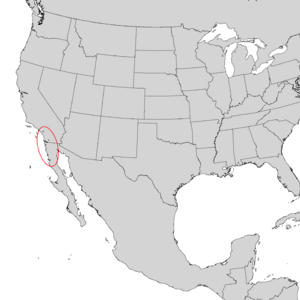 |
|
| Natural range of Cupressus forbesii | |
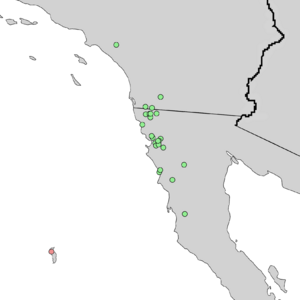 |
|
| Cupressus forbesii (green) Cupressus guadalupensis (red) |
|
| Synonyms | |
|
Synonymy
Cupressus guadalupensis var. forbesii (Jepson) Little
Callitropsis forbesii (Jeps.) D.P.Little Cupressus guadalupensis subsp. forbesi (Jeps.) Beauch. Cupressus guadalupensis subsp. forbesii (Jeps.) R.M.Beauch. Hesperocyparis forbesii (Jeps.) Bartel Neocupressus guadalupensis var. forbesii (Jeps.) de Laub. |
|
The Tecate cypress (also called Forbes' cypress) is a special type of cypress tree. Its scientific name is Cupressus forbesii. Some scientists now call it Hesperocyparis forbesii. This tree grows naturally in southwestern North America.
Contents
Where the Tecate Cypress Lives
The Tecate cypress grows in mountain chaparral and woodland areas. You can find it at elevations from about 1,475 to 4,920 feet (450 to 1,500 meters).
This tree is only found in a few places. It lives in the Santa Ana Mountains in Orange County. It also grows in San Diego County in Southern California. You can also find it in northern Baja California state in Mexico.
A large group of these trees in Orange County was hit by a wildfire in 2006. This fire was near Coal Canyon and Sierra Peak. Not many old trees survived the fire. But many new trees are now growing there. If another fire happens before these young trees can make cones, they might disappear from that area.
What the Tecate Cypress Looks Like
The Tecate cypress can grow up to 33 feet (10 meters) tall. It often has many trunks instead of one main trunk. Its leaves are a bright light green color. The seed cones are dark brown and measure about 0.8 to 1.3 inches (20–32 mm).
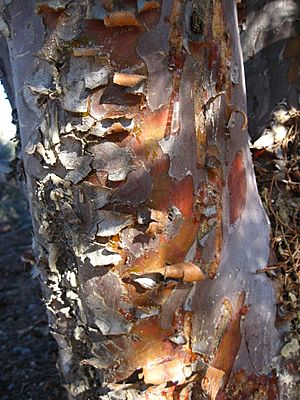
How Scientists Classify the Tecate Cypress
For a while, the Tecate cypress (Cupressus forbesii) was thought to be a type of Cupressus guadalupensis. It was called Cupressus guadalupensis var. forbesii. But scientists have studied the trees' shapes and their DNA. They found that Cupressus guadalupensis is different enough to be its own species.
Cupressus guadalupensis lives only on Guadalupe Island. This island is off the coast of Baja California, about 250 miles from where Tecate cypress trees grow. DNA tests show that Cupressus guadalupensis is actually more closely related to Cupressus stephensonii.
There are some clear differences between the Tecate cypress and the Guadalupe cypress:
- The Guadalupe cypress grows much bigger and taller when it is fully grown.
- The Guadalupe cypress has blue-green leaves. The Tecate cypress has very green leaves.
- Guadalupe cypress cones open on their own without fire. Tecate cypress cones are special. They will not open unless they are heated, even if they fall off the tree.
Tecate Cypress and Other Living Things
The Tecate cypress is very important to a rare butterfly. This butterfly is called the Thorne's Hairstreak (Callophrys gryneus thornei). The Tecate cypress is the only plant where this butterfly lays its eggs.
Growing Tecate Cypress Trees
People have found that the Tecate cypress grows well in gardens. It can handle the cool temperatures and humidity near the California coast. Other cypress trees from inland areas do not grow as well in these conditions. A Tecate cypress tree planted at the Strybing Arboretum in San Francisco is growing strong. It even produces cones when it is 40 years old.



